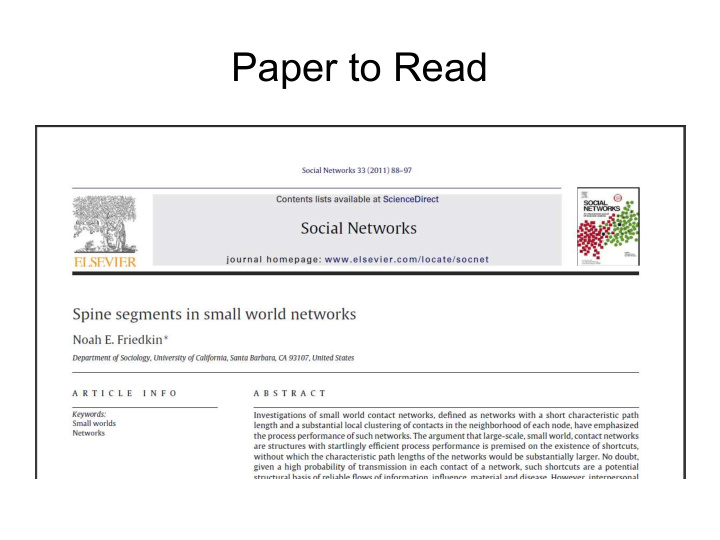



Paper to Read
Introducing • Noah Friedkin, Department of Sociology, University of California, Santa Barbara • Title: Spine segments in small world networks • Social Networks, Volume 33, Issue 1 (January 2011), pp.88–97
Thesis of paper • Investigation of large-scale groups... with works on small-world contact networks • Particular structural features of large-scale networks enable reliable transmission...
While acknowledging the Watts- Strogatz model...
The author argues that... • While the shortcuts provides efficient communication channels between different parts of a system... • the reliability of such links is called into question. • When a fixed contact networks is assumed, whether performance of transmission is "ambiguous" (p.89)
Counter argument... • citing Granovetter 1973: that average edge of the cliques of contact network is more reliable than the shortcut edge • empirically edges of small-world networks are clustered • therefore, pointing to implication of edge-failure probabilities and path redundancies.
Reachability Matrix • Valued network with edge values being probability whether active or inactive transmission. • Matrix showing node i either reaches node j or not. The expectation that i reaches j being:
Idealized structure... • Spine segments that occur in a graph in which all pairs of nodes at distance > 2 are joined by sequentially intersecting cliques. • citing Johnsen 1985, and White et al 1976 • citing earlier work (Friedkin 1998) sequential intersections are denoted as spines of ridge structure... shortcuts as structural anomalies.
Spine segments
Nature of shortcuts (p.92) • Shortcuts are structural anomalies in the graph of R (sequentially intersecting cliques)... • end points of shortcut are not structurally equivalent with the nodes
On simulation results... • all things being equal, as probability of edge failure decreases, the PTS (parallel transmission subsystem, inside the spine segment) reliability value increases • and, as path redundancy increases, so does the PTS reliability value (in relative terms)
Concluding... • theoretical importance of clustering as great as shortcuts in small world networks (p.93) • when local clustering generates a sequence of intersecting cliques, then path redundancy is an implicated structural feature of such sequences (p.93) • citing Granovetter 1973: research in "local bridges" does not support the emphasis placed on shortcut
Remarks... • The graphic adjacency of nodes in the helix representation does not imply spatial proximity • The helices with a backbone that competes with their edge sets could take either 2-dimensional, 3-dimensional (and higher dimension?) form. [p.94] • The compact helix form is suggestive when reliability of transmission among elementary nodes is important.
Algorithm ... • The model being proposed is NP-complete. (Stating this as obvious, not exactly proving this, on p.95 Appendix A) • Suggest a random algorithm and showing that the values in the reliability matrix actually converge.
Paper to Read
Recommend
More recommend